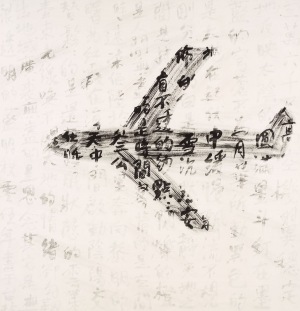
|
 |
FUNG MING CHIP SOLO EXHIBITION
AT HONG KONG INTERNATIONAL ART FAIR 2011 |
|
 |
| FUNG MING CHIP |
|
 |
|
|
|
| |
|
|
|
| |
|
EXHIBITION DURATION
26 MAY - 6 JUN, 2011 |
|
| |
|
EXHIBITION ADDRESS
ART HK 11
3E01, HALL 3E
THE HONG KONG CONVENTION AND EXHIBITION CENTRE
1 EXPO DRIVE, WANCHAI, HONG KONG
26 MAY - 29 MAY
SIN SIN ANNEX
52 - 53 SAI STREET, CENTRAL, HONG KONG
26 MAY - 6 JUN |
|
 |
|
|
 |

| Departure,-Sand-Script-10p5,
|
|
 |
|
|
Sin Sin Fine Art is pleased to present the contemporary calligraphic works of Hong Kong artist Fung Ming Chip at the Hong Kong International Art Fair (ART HK) to be held from 26 to 29 May 2011 at the Hong Kong Convention and Exhibition Centre. An adjunct show of Fung’s works will also be held at the gallery spaces at Sai Street, Central from 26 May to 6 June 2011. On Saturday 28 May 2011, Sin Sin will stage a special VIP program for ART HK at Sai Street - “Alchemical Alley”, a street music and dance performance curated by Kung Chi Shing, responding to the dynamic energy of Sai Street, where old and new Hong Kong blend in a constantly shifting movement, and to the works of Fung Ming Chip exhibited in the Sai Street spaces.
Born in a small village in China, Fung was only afforded a basic education. His early years were a journal of long hours of odd jobs to make ends meet. However, it was the trials of life that gave him the chance to pursue his interest in art. He began with seal carving when he was forced to take a break because of lung disease in 1975. Fung was not satisfied with only mastering the form and aesthetic of seal carving. He felt that seal carving should be an art of its own, independent of painting and calligraphy. To achieve this, one must understand the essence of Chinese characters and the inner logic of Chinese calligraphy. With an inquisitive mind, Fung began his cogitative journey in Chinese calligraphy, going beyond the traditional paradigm. He frequented art galleries and museums after he moved to New York in 1977. The exposure to western art provided him a broader conceptual framework to contemplate on Chinese calligraphy. He successfully brought new life to seal carving, mutated it into wooden carving and gave new meaning to calligraphic art. He found that time and space were unique elements of Chinese calligraphy. By deconstructing and reconstructing the inner space and time of Chinese calligraphy, he has, over the years, invented more than one hundred new scripts. Fung is also a writer. He composed most of the verses and prose in his calligraphic works, sometimes sensual, sometimes philosophical, imparting a seasoned view of the world with a sense of dry wit. While the medium remain to be ink, brush and xuan paper, his calligraphic art brings an entirely new experience in various dimensions – spatial, temporal and even melodious.
In his recent work Life/Death, Different Double Script, the character sheng 生 (life) was overwritten by a larger darker character si 死 (death) . Britta Erickson remarked that “although death does indeed follow life, life is not extinguished: it shines on through death”. This can also best describe the recent developments in Chinese calligraphy. While Chinese calligraphy’s traditional function in day-to-day writing is diminishing, it has now emerged as a new form of contemporary art opening up an array of possibilities. Fung Ming Chip is one of the early pioneers venturing into this territory. His art speaks not only to those who can read Chinese characters, it reaches to the heart and mind of people of different cultural backgrounds.
Since 1986, Fung has been travelling among New York, Hong Kong and China. His works are included in major private collections and public institutions, such as the Metropolitan Museum of Art, Harvard-Sackler Museum and Princeton University Art Museum.
Sin Sin Fine Art將會参加於2011年5月26至29日於香港會議展覽中心舉行的香港國際藝術展,屆時會展出香港藝術家馮明秋的當代書法創作。為了令觀眾對馮明秋的作品有更全面的認識,Sin Sin Fine Art同期於西街舉行馮明秋個展,展期由5月26日至6月6日。而5月28日星期六晚上,將於西街為香港國際藝術展的貴賓舉行「西街‧南音」街頭音樂舞蹈表演 - 由龔志成策展,回應西街的新舊交融及多元動力,並與馮明秋的作品對話。
馮明秋生於中國一條小村落,自幼家貧,小學畢業後當小工雜役,為口奔馳,但正正也是生活的壓力促使他追尋自己對藝術的興趣 - 1975年因肺病迫不得已停下來,自此便展開篆刻創作。馮明秋並沒有因為掌握篆刻的技巧和美學而自滿,他認為篆刻本身應該是一門獨立的藝術,不用依附於書畫。要達致這個境界,便必先要了解中國文字的精髓及書法的內在邏輯。他跳出傳統的思維,以鍥而不捨的精神去探究問題的核心。自1977年移居美國後,便常常參觀畫廊博物館,眼界大開。對西方藝術的認識,令他有更廣闊的視野和概念框架去重新審視中國書法藝術。經過不斷的嘗試,終於成功將篆刻帶進更高的層次,更演化成木刻,並為書法注入新意。多年埋首鑽研之後,馮明秋恍然大悟,發現書法藝術的特質其實是時間和空間。通過解構及重組書法的內在時間和空間,他在過去十數年間已創作出過百種字體。馮明秋也是一位作家,作品中的詩句及隨想,都是出自他手筆,時而感性、時而充滿哲理,冷眼旁觀世情,卻不失一絲幽默。所用的物料雖然傳統,不離宣紙毛筆水墨,但所帶來的體驗,卻是嶄新而多層次的 - 時間、空間和內在的韻律。
馮明秋的近作《生死異雙字》,較大的「死」字覆寫在「生」字之上。林似竹(Britta Erickson)有這樣的感想:「『死』隨生而來,但『生』並未因而失色,反而照亮了死亡。」正好也是當前中國書法的寫照;書法於日常書寫的傳統功能雖日漸息微,但卻重生為一門創新的當代藝術,開拓無限的可能性。馮明秋是當代書法藝術的先行者,打破不同文化的彊界,就是不懂閱讀中文,也能夠欣賞,並有所體會。
自1986年始,馮明秋穿梭於紐約、香港及中國三地。他的作品廣受私人藏家及公營機構如 Metropolitan Museum of Art, Harvard-Sackler Museum 及 Princeton University Art Museum等所收藏。
|
|
|
